Case Study on Assertiveness: Analyzing Workplace Communication
VerifiedAdded on 2020/01/28
|9
|2497
|604
Report
AI Summary
This report presents a case study analyzing a scenario involving an executive secretary, Sarah, and her demanding boss. Sarah, overworked and seeking assistance, confronts her boss due to excessive workload and lack of support. The report explores the importance of assertiveness in the workplace, defining it as self-assured communication without aggression. It examines reasons for choosing assertiveness, including improved self-image, understanding others, and self-confidence. The report then outlines characteristics of an assertive person, such as expressing feelings, initiating conversations, and accepting compliments. Justification of Sarah's action is also provided. Furthermore, the report recommends the "Fogging" technique and the DESC approach to improve communication and resolve conflicts, offering practical strategies for assertive behavior in professional settings. The report concludes with an overview of the concepts discussed.
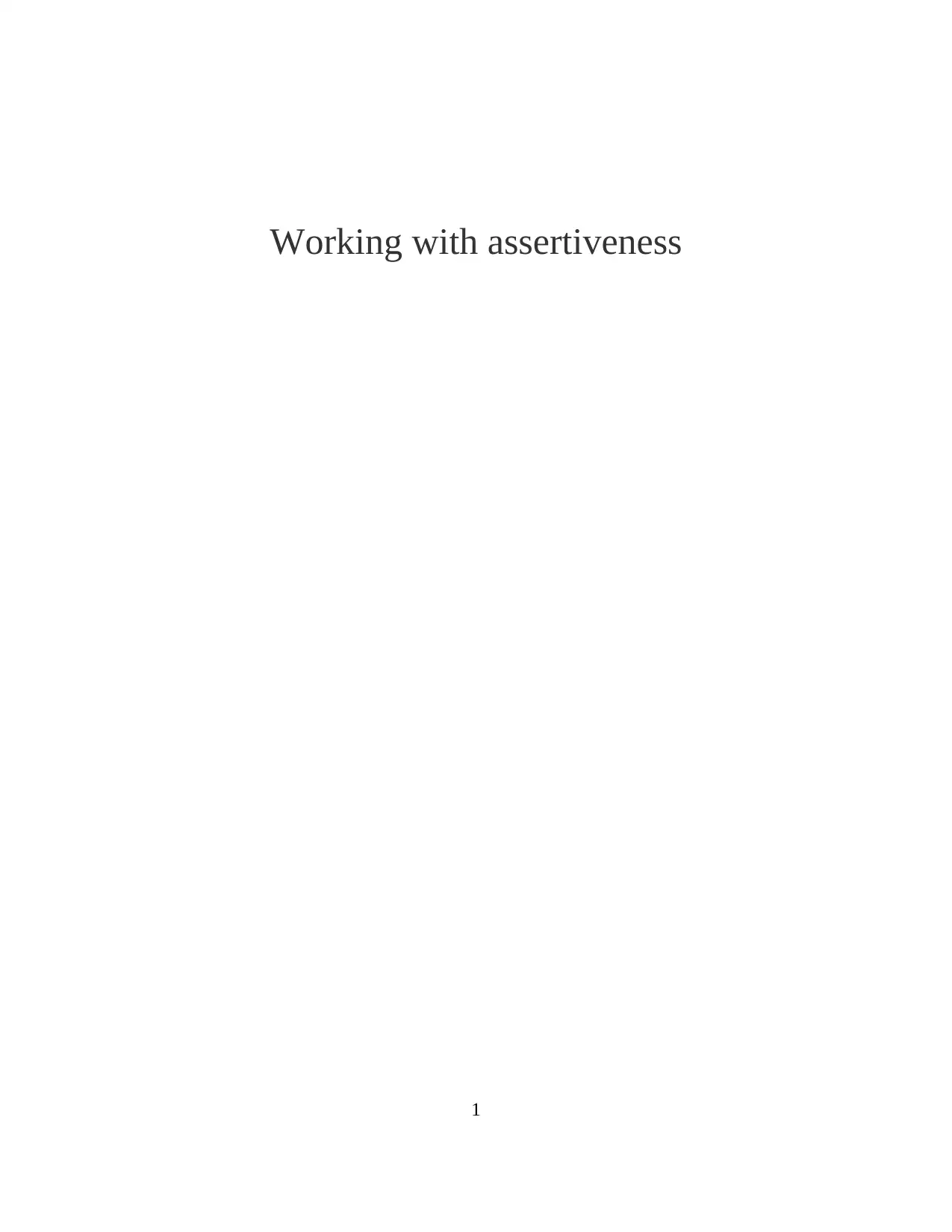
Working with assertiveness
1
1
Paraphrase This Document
Need a fresh take? Get an instant paraphrase of this document with our AI Paraphraser
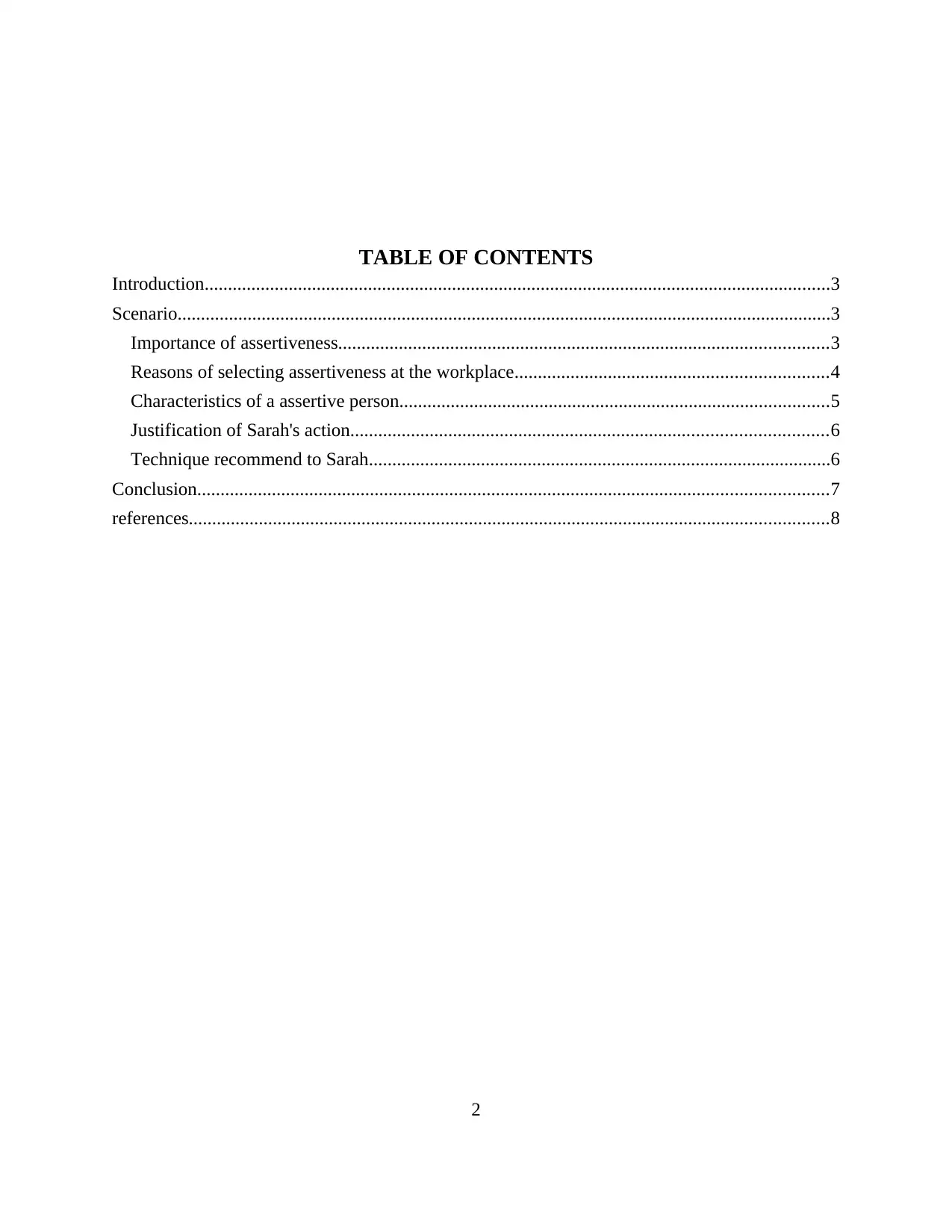
TABLE OF CONTENTS
Introduction......................................................................................................................................3
Scenario............................................................................................................................................3
Importance of assertiveness.........................................................................................................3
Reasons of selecting assertiveness at the workplace...................................................................4
Characteristics of a assertive person............................................................................................5
Justification of Sarah's action......................................................................................................6
Technique recommend to Sarah...................................................................................................6
Conclusion.......................................................................................................................................7
references.........................................................................................................................................8
2
Introduction......................................................................................................................................3
Scenario............................................................................................................................................3
Importance of assertiveness.........................................................................................................3
Reasons of selecting assertiveness at the workplace...................................................................4
Characteristics of a assertive person............................................................................................5
Justification of Sarah's action......................................................................................................6
Technique recommend to Sarah...................................................................................................6
Conclusion.......................................................................................................................................7
references.........................................................................................................................................8
2
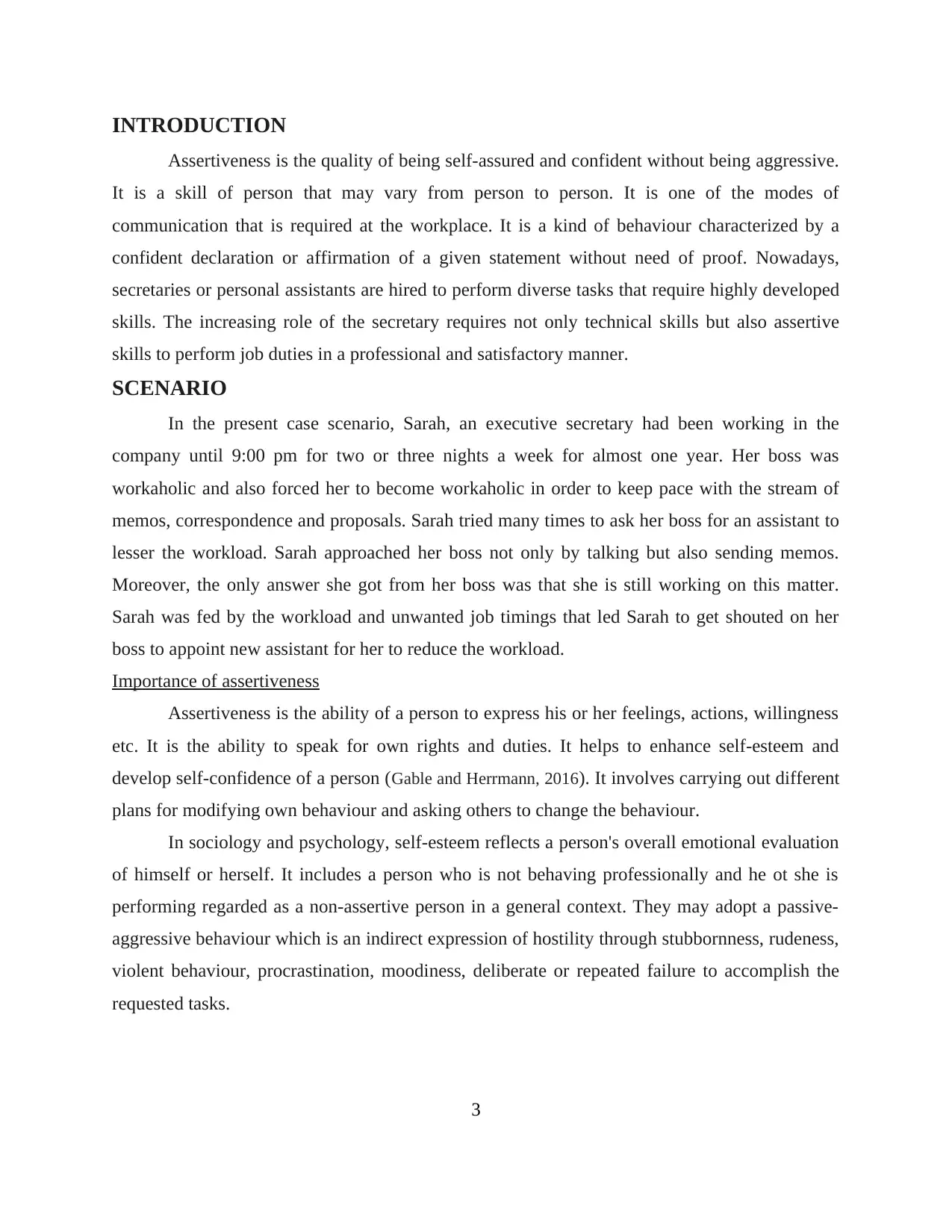
INTRODUCTION
Assertiveness is the quality of being self-assured and confident without being aggressive.
It is a skill of person that may vary from person to person. It is one of the modes of
communication that is required at the workplace. It is a kind of behaviour characterized by a
confident declaration or affirmation of a given statement without need of proof. Nowadays,
secretaries or personal assistants are hired to perform diverse tasks that require highly developed
skills. The increasing role of the secretary requires not only technical skills but also assertive
skills to perform job duties in a professional and satisfactory manner.
SCENARIO
In the present case scenario, Sarah, an executive secretary had been working in the
company until 9:00 pm for two or three nights a week for almost one year. Her boss was
workaholic and also forced her to become workaholic in order to keep pace with the stream of
memos, correspondence and proposals. Sarah tried many times to ask her boss for an assistant to
lesser the workload. Sarah approached her boss not only by talking but also sending memos.
Moreover, the only answer she got from her boss was that she is still working on this matter.
Sarah was fed by the workload and unwanted job timings that led Sarah to get shouted on her
boss to appoint new assistant for her to reduce the workload.
Importance of assertiveness
Assertiveness is the ability of a person to express his or her feelings, actions, willingness
etc. It is the ability to speak for own rights and duties. It helps to enhance self-esteem and
develop self-confidence of a person (Gable and Herrmann, 2016). It involves carrying out different
plans for modifying own behaviour and asking others to change the behaviour.
In sociology and psychology, self-esteem reflects a person's overall emotional evaluation
of himself or herself. It includes a person who is not behaving professionally and he ot she is
performing regarded as a non-assertive person in a general context. They may adopt a passive-
aggressive behaviour which is an indirect expression of hostility through stubbornness, rudeness,
violent behaviour, procrastination, moodiness, deliberate or repeated failure to accomplish the
requested tasks.
3
Assertiveness is the quality of being self-assured and confident without being aggressive.
It is a skill of person that may vary from person to person. It is one of the modes of
communication that is required at the workplace. It is a kind of behaviour characterized by a
confident declaration or affirmation of a given statement without need of proof. Nowadays,
secretaries or personal assistants are hired to perform diverse tasks that require highly developed
skills. The increasing role of the secretary requires not only technical skills but also assertive
skills to perform job duties in a professional and satisfactory manner.
SCENARIO
In the present case scenario, Sarah, an executive secretary had been working in the
company until 9:00 pm for two or three nights a week for almost one year. Her boss was
workaholic and also forced her to become workaholic in order to keep pace with the stream of
memos, correspondence and proposals. Sarah tried many times to ask her boss for an assistant to
lesser the workload. Sarah approached her boss not only by talking but also sending memos.
Moreover, the only answer she got from her boss was that she is still working on this matter.
Sarah was fed by the workload and unwanted job timings that led Sarah to get shouted on her
boss to appoint new assistant for her to reduce the workload.
Importance of assertiveness
Assertiveness is the ability of a person to express his or her feelings, actions, willingness
etc. It is the ability to speak for own rights and duties. It helps to enhance self-esteem and
develop self-confidence of a person (Gable and Herrmann, 2016). It involves carrying out different
plans for modifying own behaviour and asking others to change the behaviour.
In sociology and psychology, self-esteem reflects a person's overall emotional evaluation
of himself or herself. It includes a person who is not behaving professionally and he ot she is
performing regarded as a non-assertive person in a general context. They may adopt a passive-
aggressive behaviour which is an indirect expression of hostility through stubbornness, rudeness,
violent behaviour, procrastination, moodiness, deliberate or repeated failure to accomplish the
requested tasks.
3
⊘ This is a preview!⊘
Do you want full access?
Subscribe today to unlock all pages.

Trusted by 1+ million students worldwide
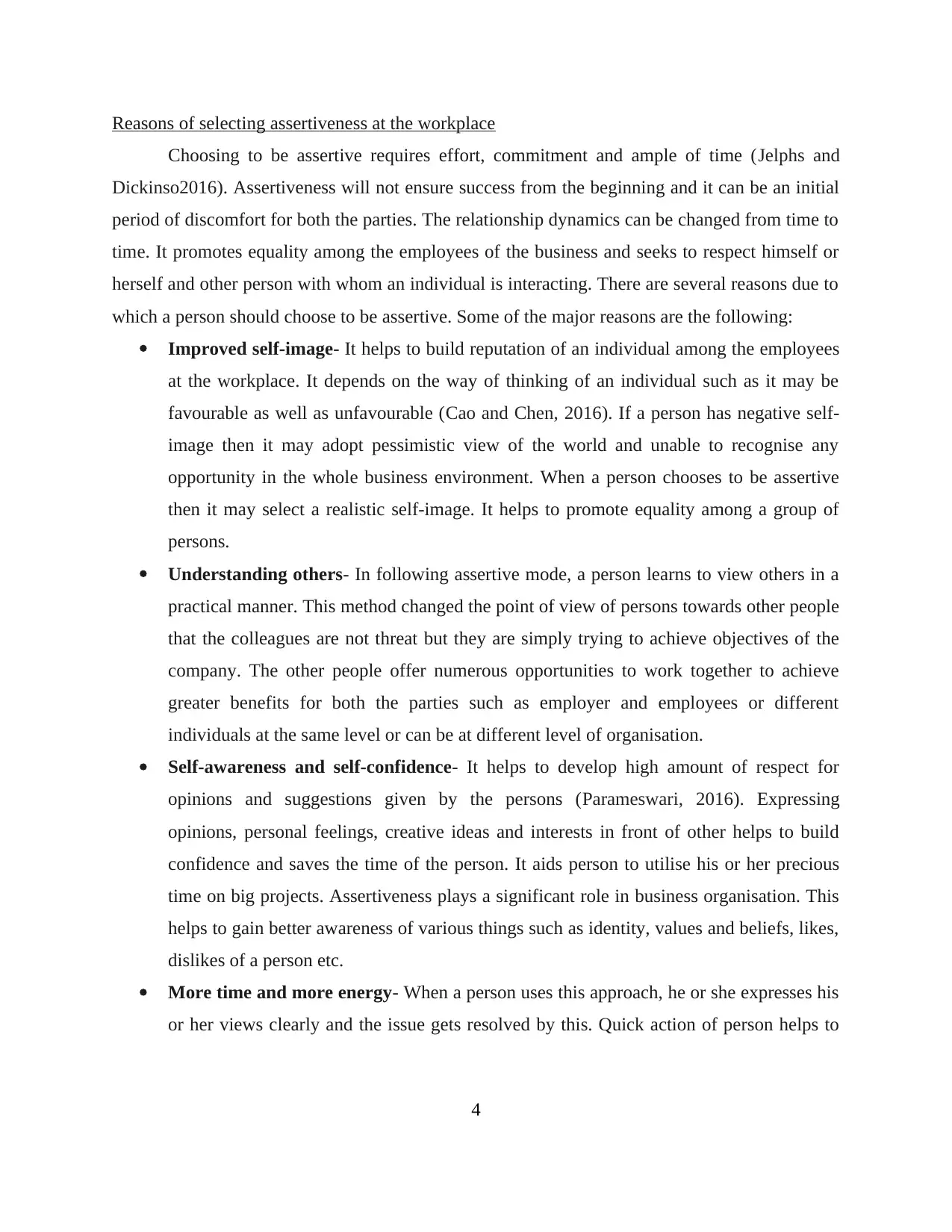
Reasons of selecting assertiveness at the workplace
Choosing to be assertive requires effort, commitment and ample of time (Jelphs and
Dickinso2016). Assertiveness will not ensure success from the beginning and it can be an initial
period of discomfort for both the parties. The relationship dynamics can be changed from time to
time. It promotes equality among the employees of the business and seeks to respect himself or
herself and other person with whom an individual is interacting. There are several reasons due to
which a person should choose to be assertive. Some of the major reasons are the following:
Improved self-image- It helps to build reputation of an individual among the employees
at the workplace. It depends on the way of thinking of an individual such as it may be
favourable as well as unfavourable (Cao and Chen, 2016). If a person has negative self-
image then it may adopt pessimistic view of the world and unable to recognise any
opportunity in the whole business environment. When a person chooses to be assertive
then it may select a realistic self-image. It helps to promote equality among a group of
persons.
Understanding others- In following assertive mode, a person learns to view others in a
practical manner. This method changed the point of view of persons towards other people
that the colleagues are not threat but they are simply trying to achieve objectives of the
company. The other people offer numerous opportunities to work together to achieve
greater benefits for both the parties such as employer and employees or different
individuals at the same level or can be at different level of organisation.
Self-awareness and self-confidence- It helps to develop high amount of respect for
opinions and suggestions given by the persons (Parameswari, 2016). Expressing
opinions, personal feelings, creative ideas and interests in front of other helps to build
confidence and saves the time of the person. It aids person to utilise his or her precious
time on big projects. Assertiveness plays a significant role in business organisation. This
helps to gain better awareness of various things such as identity, values and beliefs, likes,
dislikes of a person etc.
More time and more energy- When a person uses this approach, he or she expresses his
or her views clearly and the issue gets resolved by this. Quick action of person helps to
4
Choosing to be assertive requires effort, commitment and ample of time (Jelphs and
Dickinso2016). Assertiveness will not ensure success from the beginning and it can be an initial
period of discomfort for both the parties. The relationship dynamics can be changed from time to
time. It promotes equality among the employees of the business and seeks to respect himself or
herself and other person with whom an individual is interacting. There are several reasons due to
which a person should choose to be assertive. Some of the major reasons are the following:
Improved self-image- It helps to build reputation of an individual among the employees
at the workplace. It depends on the way of thinking of an individual such as it may be
favourable as well as unfavourable (Cao and Chen, 2016). If a person has negative self-
image then it may adopt pessimistic view of the world and unable to recognise any
opportunity in the whole business environment. When a person chooses to be assertive
then it may select a realistic self-image. It helps to promote equality among a group of
persons.
Understanding others- In following assertive mode, a person learns to view others in a
practical manner. This method changed the point of view of persons towards other people
that the colleagues are not threat but they are simply trying to achieve objectives of the
company. The other people offer numerous opportunities to work together to achieve
greater benefits for both the parties such as employer and employees or different
individuals at the same level or can be at different level of organisation.
Self-awareness and self-confidence- It helps to develop high amount of respect for
opinions and suggestions given by the persons (Parameswari, 2016). Expressing
opinions, personal feelings, creative ideas and interests in front of other helps to build
confidence and saves the time of the person. It aids person to utilise his or her precious
time on big projects. Assertiveness plays a significant role in business organisation. This
helps to gain better awareness of various things such as identity, values and beliefs, likes,
dislikes of a person etc.
More time and more energy- When a person uses this approach, he or she expresses his
or her views clearly and the issue gets resolved by this. Quick action of person helps to
4
Paraphrase This Document
Need a fresh take? Get an instant paraphrase of this document with our AI Paraphraser
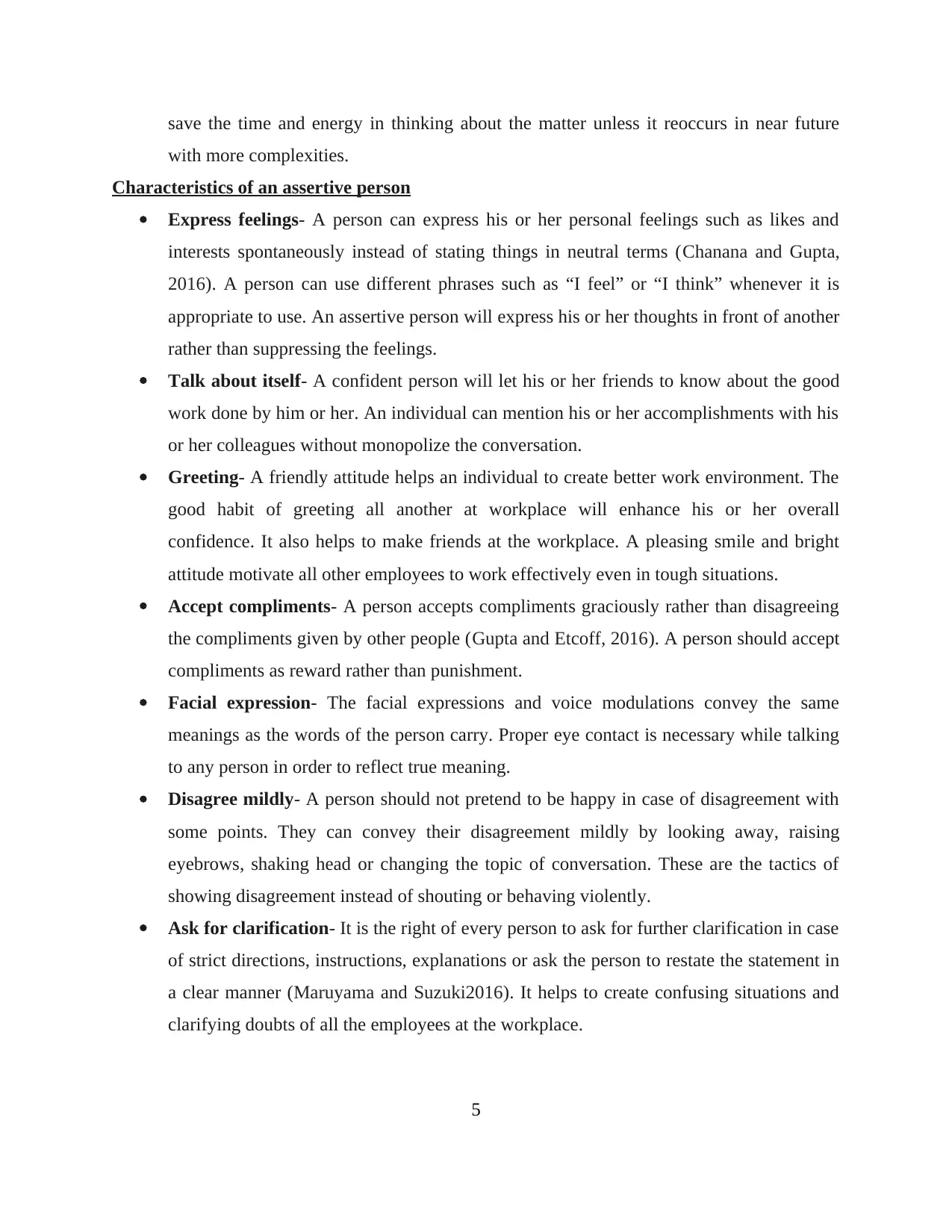
save the time and energy in thinking about the matter unless it reoccurs in near future
with more complexities.
Characteristics of an assertive person
Express feelings- A person can express his or her personal feelings such as likes and
interests spontaneously instead of stating things in neutral terms (Chanana and Gupta,
2016). A person can use different phrases such as “I feel” or “I think” whenever it is
appropriate to use. An assertive person will express his or her thoughts in front of another
rather than suppressing the feelings.
Talk about itself- A confident person will let his or her friends to know about the good
work done by him or her. An individual can mention his or her accomplishments with his
or her colleagues without monopolize the conversation.
Greeting- A friendly attitude helps an individual to create better work environment. The
good habit of greeting all another at workplace will enhance his or her overall
confidence. It also helps to make friends at the workplace. A pleasing smile and bright
attitude motivate all other employees to work effectively even in tough situations.
Accept compliments- A person accepts compliments graciously rather than disagreeing
the compliments given by other people (Gupta and Etcoff, 2016). A person should accept
compliments as reward rather than punishment.
Facial expression- The facial expressions and voice modulations convey the same
meanings as the words of the person carry. Proper eye contact is necessary while talking
to any person in order to reflect true meaning.
Disagree mildly- A person should not pretend to be happy in case of disagreement with
some points. They can convey their disagreement mildly by looking away, raising
eyebrows, shaking head or changing the topic of conversation. These are the tactics of
showing disagreement instead of shouting or behaving violently.
Ask for clarification- It is the right of every person to ask for further clarification in case
of strict directions, instructions, explanations or ask the person to restate the statement in
a clear manner (Maruyama and Suzuki2016). It helps to create confusing situations and
clarifying doubts of all the employees at the workplace.
5
with more complexities.
Characteristics of an assertive person
Express feelings- A person can express his or her personal feelings such as likes and
interests spontaneously instead of stating things in neutral terms (Chanana and Gupta,
2016). A person can use different phrases such as “I feel” or “I think” whenever it is
appropriate to use. An assertive person will express his or her thoughts in front of another
rather than suppressing the feelings.
Talk about itself- A confident person will let his or her friends to know about the good
work done by him or her. An individual can mention his or her accomplishments with his
or her colleagues without monopolize the conversation.
Greeting- A friendly attitude helps an individual to create better work environment. The
good habit of greeting all another at workplace will enhance his or her overall
confidence. It also helps to make friends at the workplace. A pleasing smile and bright
attitude motivate all other employees to work effectively even in tough situations.
Accept compliments- A person accepts compliments graciously rather than disagreeing
the compliments given by other people (Gupta and Etcoff, 2016). A person should accept
compliments as reward rather than punishment.
Facial expression- The facial expressions and voice modulations convey the same
meanings as the words of the person carry. Proper eye contact is necessary while talking
to any person in order to reflect true meaning.
Disagree mildly- A person should not pretend to be happy in case of disagreement with
some points. They can convey their disagreement mildly by looking away, raising
eyebrows, shaking head or changing the topic of conversation. These are the tactics of
showing disagreement instead of shouting or behaving violently.
Ask for clarification- It is the right of every person to ask for further clarification in case
of strict directions, instructions, explanations or ask the person to restate the statement in
a clear manner (Maruyama and Suzuki2016). It helps to create confusing situations and
clarifying doubts of all the employees at the workplace.
5
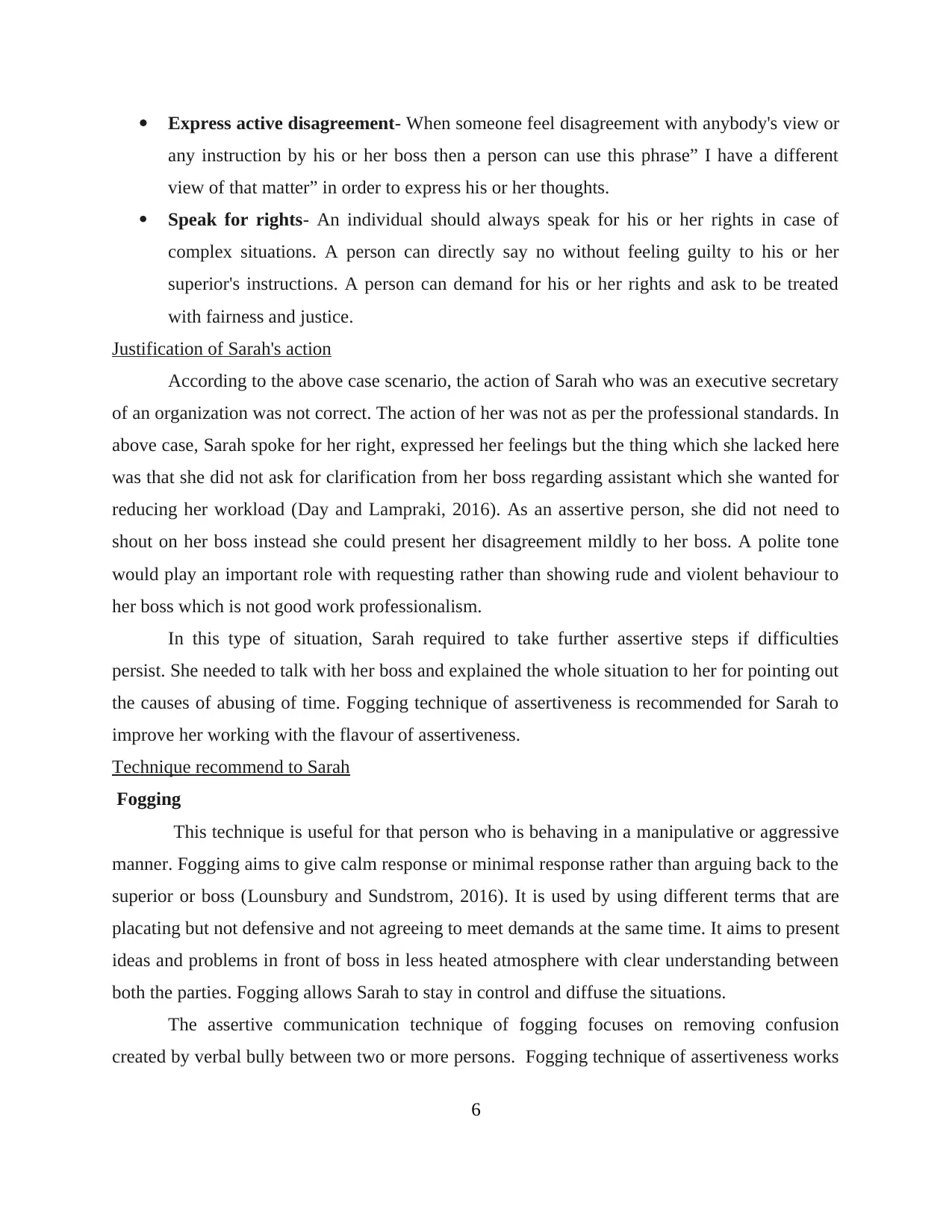
Express active disagreement- When someone feel disagreement with anybody's view or
any instruction by his or her boss then a person can use this phrase” I have a different
view of that matter” in order to express his or her thoughts.
Speak for rights- An individual should always speak for his or her rights in case of
complex situations. A person can directly say no without feeling guilty to his or her
superior's instructions. A person can demand for his or her rights and ask to be treated
with fairness and justice.
Justification of Sarah's action
According to the above case scenario, the action of Sarah who was an executive secretary
of an organization was not correct. The action of her was not as per the professional standards. In
above case, Sarah spoke for her right, expressed her feelings but the thing which she lacked here
was that she did not ask for clarification from her boss regarding assistant which she wanted for
reducing her workload (Day and Lampraki, 2016). As an assertive person, she did not need to
shout on her boss instead she could present her disagreement mildly to her boss. A polite tone
would play an important role with requesting rather than showing rude and violent behaviour to
her boss which is not good work professionalism.
In this type of situation, Sarah required to take further assertive steps if difficulties
persist. She needed to talk with her boss and explained the whole situation to her for pointing out
the causes of abusing of time. Fogging technique of assertiveness is recommended for Sarah to
improve her working with the flavour of assertiveness.
Technique recommend to Sarah
Fogging
This technique is useful for that person who is behaving in a manipulative or aggressive
manner. Fogging aims to give calm response or minimal response rather than arguing back to the
superior or boss (Lounsbury and Sundstrom, 2016). It is used by using different terms that are
placating but not defensive and not agreeing to meet demands at the same time. It aims to present
ideas and problems in front of boss in less heated atmosphere with clear understanding between
both the parties. Fogging allows Sarah to stay in control and diffuse the situations.
The assertive communication technique of fogging focuses on removing confusion
created by verbal bully between two or more persons. Fogging technique of assertiveness works
6
any instruction by his or her boss then a person can use this phrase” I have a different
view of that matter” in order to express his or her thoughts.
Speak for rights- An individual should always speak for his or her rights in case of
complex situations. A person can directly say no without feeling guilty to his or her
superior's instructions. A person can demand for his or her rights and ask to be treated
with fairness and justice.
Justification of Sarah's action
According to the above case scenario, the action of Sarah who was an executive secretary
of an organization was not correct. The action of her was not as per the professional standards. In
above case, Sarah spoke for her right, expressed her feelings but the thing which she lacked here
was that she did not ask for clarification from her boss regarding assistant which she wanted for
reducing her workload (Day and Lampraki, 2016). As an assertive person, she did not need to
shout on her boss instead she could present her disagreement mildly to her boss. A polite tone
would play an important role with requesting rather than showing rude and violent behaviour to
her boss which is not good work professionalism.
In this type of situation, Sarah required to take further assertive steps if difficulties
persist. She needed to talk with her boss and explained the whole situation to her for pointing out
the causes of abusing of time. Fogging technique of assertiveness is recommended for Sarah to
improve her working with the flavour of assertiveness.
Technique recommend to Sarah
Fogging
This technique is useful for that person who is behaving in a manipulative or aggressive
manner. Fogging aims to give calm response or minimal response rather than arguing back to the
superior or boss (Lounsbury and Sundstrom, 2016). It is used by using different terms that are
placating but not defensive and not agreeing to meet demands at the same time. It aims to present
ideas and problems in front of boss in less heated atmosphere with clear understanding between
both the parties. Fogging allows Sarah to stay in control and diffuse the situations.
The assertive communication technique of fogging focuses on removing confusion
created by verbal bully between two or more persons. Fogging technique of assertiveness works
6
⊘ This is a preview!⊘
Do you want full access?
Subscribe today to unlock all pages.

Trusted by 1+ million students worldwide
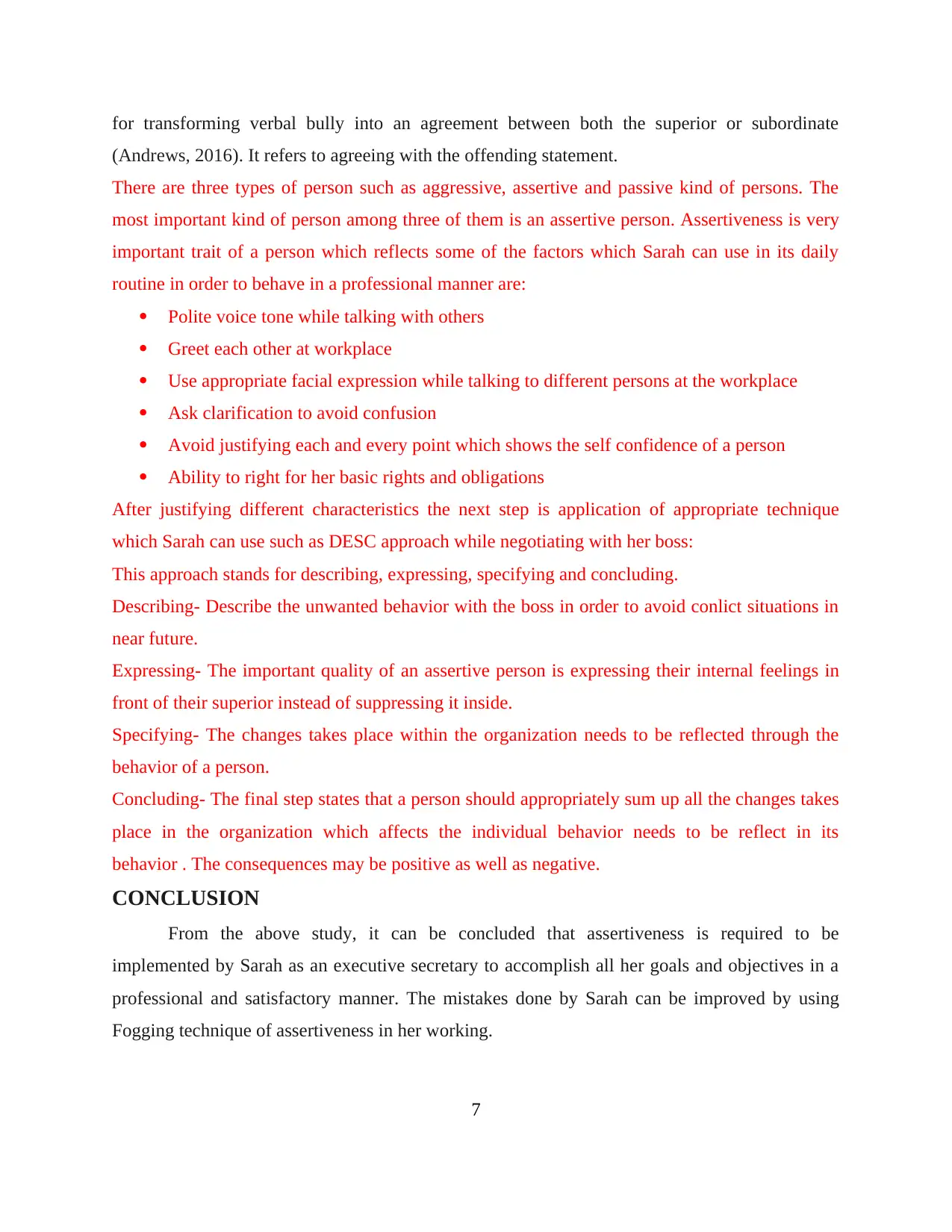
for transforming verbal bully into an agreement between both the superior or subordinate
(Andrews, 2016). It refers to agreeing with the offending statement.
There are three types of person such as aggressive, assertive and passive kind of persons. The
most important kind of person among three of them is an assertive person. Assertiveness is very
important trait of a person which reflects some of the factors which Sarah can use in its daily
routine in order to behave in a professional manner are:
Polite voice tone while talking with others
Greet each other at workplace
Use appropriate facial expression while talking to different persons at the workplace
Ask clarification to avoid confusion
Avoid justifying each and every point which shows the self confidence of a person
Ability to right for her basic rights and obligations
After justifying different characteristics the next step is application of appropriate technique
which Sarah can use such as DESC approach while negotiating with her boss:
This approach stands for describing, expressing, specifying and concluding.
Describing- Describe the unwanted behavior with the boss in order to avoid conlict situations in
near future.
Expressing- The important quality of an assertive person is expressing their internal feelings in
front of their superior instead of suppressing it inside.
Specifying- The changes takes place within the organization needs to be reflected through the
behavior of a person.
Concluding- The final step states that a person should appropriately sum up all the changes takes
place in the organization which affects the individual behavior needs to be reflect in its
behavior . The consequences may be positive as well as negative.
CONCLUSION
From the above study, it can be concluded that assertiveness is required to be
implemented by Sarah as an executive secretary to accomplish all her goals and objectives in a
professional and satisfactory manner. The mistakes done by Sarah can be improved by using
Fogging technique of assertiveness in her working.
7
(Andrews, 2016). It refers to agreeing with the offending statement.
There are three types of person such as aggressive, assertive and passive kind of persons. The
most important kind of person among three of them is an assertive person. Assertiveness is very
important trait of a person which reflects some of the factors which Sarah can use in its daily
routine in order to behave in a professional manner are:
Polite voice tone while talking with others
Greet each other at workplace
Use appropriate facial expression while talking to different persons at the workplace
Ask clarification to avoid confusion
Avoid justifying each and every point which shows the self confidence of a person
Ability to right for her basic rights and obligations
After justifying different characteristics the next step is application of appropriate technique
which Sarah can use such as DESC approach while negotiating with her boss:
This approach stands for describing, expressing, specifying and concluding.
Describing- Describe the unwanted behavior with the boss in order to avoid conlict situations in
near future.
Expressing- The important quality of an assertive person is expressing their internal feelings in
front of their superior instead of suppressing it inside.
Specifying- The changes takes place within the organization needs to be reflected through the
behavior of a person.
Concluding- The final step states that a person should appropriately sum up all the changes takes
place in the organization which affects the individual behavior needs to be reflect in its
behavior . The consequences may be positive as well as negative.
CONCLUSION
From the above study, it can be concluded that assertiveness is required to be
implemented by Sarah as an executive secretary to accomplish all her goals and objectives in a
professional and satisfactory manner. The mistakes done by Sarah can be improved by using
Fogging technique of assertiveness in her working.
7
Paraphrase This Document
Need a fresh take? Get an instant paraphrase of this document with our AI Paraphraser

8
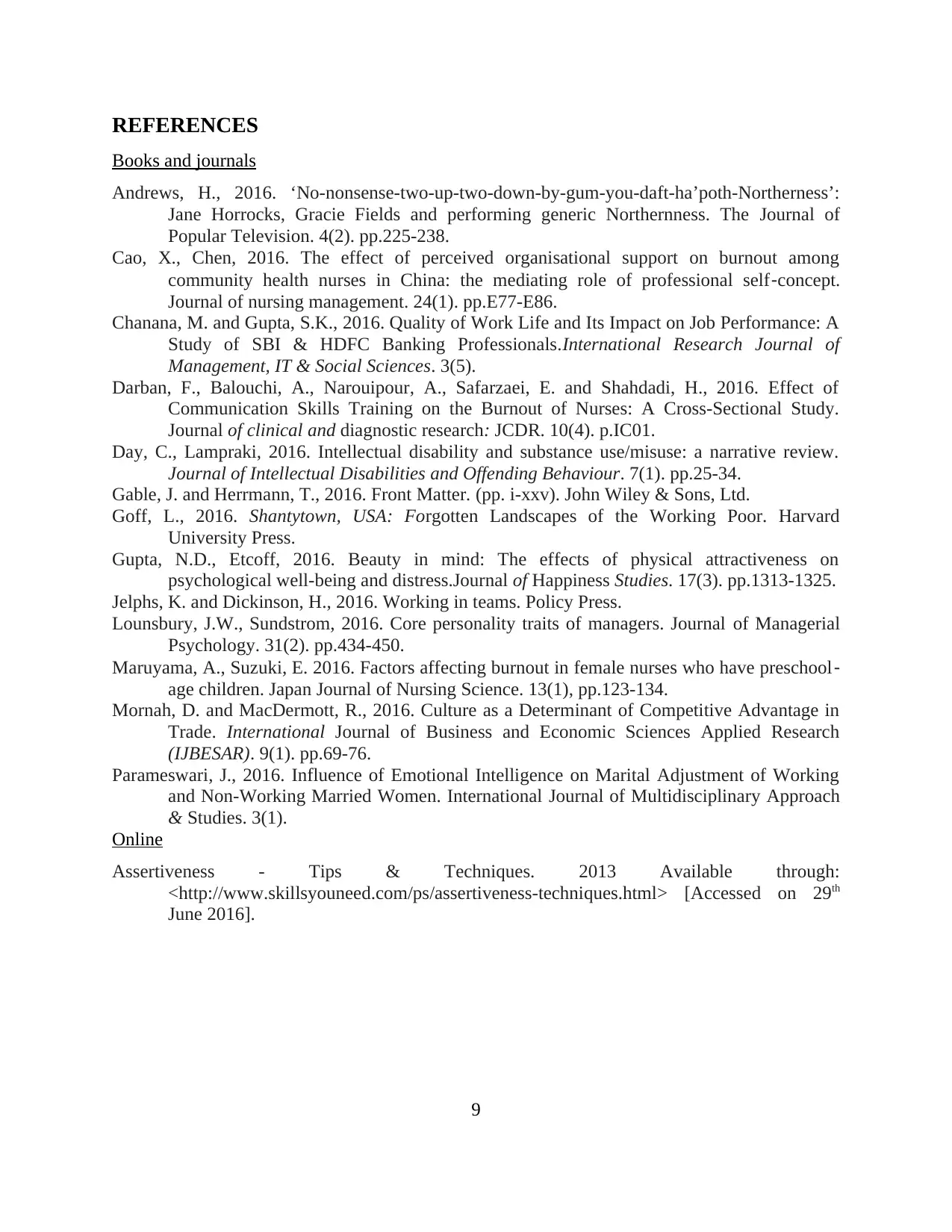
REFERENCES
Books and journals
Andrews, H., 2016. ‘No-nonsense-two-up-two-down-by-gum-you-daft-ha’poth-Northerness’:
Jane Horrocks, Gracie Fields and performing generic Northernness. The Journal of
Popular Television. 4(2). pp.225-238.
Cao, X., Chen, 2016. The effect of perceived organisational support on burnout among
community health nurses in China: the mediating role of professional self‐concept.
Journal of nursing management. 24(1). pp.E77-E86.
Chanana, M. and Gupta, S.K., 2016. Quality of Work Life and Its Impact on Job Performance: A
Study of SBI & HDFC Banking Professionals.International Research Journal of
Management, IT & Social Sciences. 3(5).
Darban, F., Balouchi, A., Narouipour, A., Safarzaei, E. and Shahdadi, H., 2016. Effect of
Communication Skills Training on the Burnout of Nurses: A Cross-Sectional Study.
Journal of clinical and diagnostic research: JCDR. 10(4). p.IC01.
Day, C., Lampraki, 2016. Intellectual disability and substance use/misuse: a narrative review.
Journal of Intellectual Disabilities and Offending Behaviour. 7(1). pp.25-34.
Gable, J. and Herrmann, T., 2016. Front Matter. (pp. i-xxv). John Wiley & Sons, Ltd.
Goff, L., 2016. Shantytown, USA: Forgotten Landscapes of the Working Poor. Harvard
University Press.
Gupta, N.D., Etcoff, 2016. Beauty in mind: The effects of physical attractiveness on
psychological well-being and distress.Journal of Happiness Studies. 17(3). pp.1313-1325.
Jelphs, K. and Dickinson, H., 2016. Working in teams. Policy Press.
Lounsbury, J.W., Sundstrom, 2016. Core personality traits of managers. Journal of Managerial
Psychology. 31(2). pp.434-450.
Maruyama, A., Suzuki, E. 2016. Factors affecting burnout in female nurses who have preschool‐
age children. Japan Journal of Nursing Science. 13(1), pp.123-134.
Mornah, D. and MacDermott, R., 2016. Culture as a Determinant of Competitive Advantage in
Trade. International Journal of Business and Economic Sciences Applied Research
(IJBESAR). 9(1). pp.69-76.
Parameswari, J., 2016. Influence of Emotional Intelligence on Marital Adjustment of Working
and Non-Working Married Women. International Journal of Multidisciplinary Approach
& Studies. 3(1).
Online
Assertiveness - Tips & Techniques. 2013 Available through:
<http://www.skillsyouneed.com/ps/assertiveness-techniques.html> [Accessed on 29th
June 2016].
9
Books and journals
Andrews, H., 2016. ‘No-nonsense-two-up-two-down-by-gum-you-daft-ha’poth-Northerness’:
Jane Horrocks, Gracie Fields and performing generic Northernness. The Journal of
Popular Television. 4(2). pp.225-238.
Cao, X., Chen, 2016. The effect of perceived organisational support on burnout among
community health nurses in China: the mediating role of professional self‐concept.
Journal of nursing management. 24(1). pp.E77-E86.
Chanana, M. and Gupta, S.K., 2016. Quality of Work Life and Its Impact on Job Performance: A
Study of SBI & HDFC Banking Professionals.International Research Journal of
Management, IT & Social Sciences. 3(5).
Darban, F., Balouchi, A., Narouipour, A., Safarzaei, E. and Shahdadi, H., 2016. Effect of
Communication Skills Training on the Burnout of Nurses: A Cross-Sectional Study.
Journal of clinical and diagnostic research: JCDR. 10(4). p.IC01.
Day, C., Lampraki, 2016. Intellectual disability and substance use/misuse: a narrative review.
Journal of Intellectual Disabilities and Offending Behaviour. 7(1). pp.25-34.
Gable, J. and Herrmann, T., 2016. Front Matter. (pp. i-xxv). John Wiley & Sons, Ltd.
Goff, L., 2016. Shantytown, USA: Forgotten Landscapes of the Working Poor. Harvard
University Press.
Gupta, N.D., Etcoff, 2016. Beauty in mind: The effects of physical attractiveness on
psychological well-being and distress.Journal of Happiness Studies. 17(3). pp.1313-1325.
Jelphs, K. and Dickinson, H., 2016. Working in teams. Policy Press.
Lounsbury, J.W., Sundstrom, 2016. Core personality traits of managers. Journal of Managerial
Psychology. 31(2). pp.434-450.
Maruyama, A., Suzuki, E. 2016. Factors affecting burnout in female nurses who have preschool‐
age children. Japan Journal of Nursing Science. 13(1), pp.123-134.
Mornah, D. and MacDermott, R., 2016. Culture as a Determinant of Competitive Advantage in
Trade. International Journal of Business and Economic Sciences Applied Research
(IJBESAR). 9(1). pp.69-76.
Parameswari, J., 2016. Influence of Emotional Intelligence on Marital Adjustment of Working
and Non-Working Married Women. International Journal of Multidisciplinary Approach
& Studies. 3(1).
Online
Assertiveness - Tips & Techniques. 2013 Available through:
<http://www.skillsyouneed.com/ps/assertiveness-techniques.html> [Accessed on 29th
June 2016].
9
⊘ This is a preview!⊘
Do you want full access?
Subscribe today to unlock all pages.

Trusted by 1+ million students worldwide
1 out of 9
Your All-in-One AI-Powered Toolkit for Academic Success.
+13062052269
info@desklib.com
Available 24*7 on WhatsApp / Email
![[object Object]](/_next/static/media/star-bottom.7253800d.svg)
Unlock your academic potential
Copyright © 2020–2025 A2Z Services. All Rights Reserved. Developed and managed by ZUCOL.
